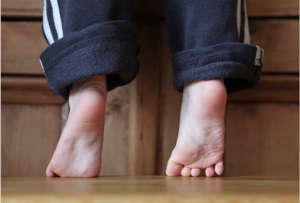
Does your child love to run, swing, and jump? Engage in messy play with finger paint and shaving cream or seek out hugs and cuddles? Or perhaps they prefer to watch other children navigate the rock wall at the playground or quickly wipe their hands clean when dirty? Our sensory systems are responsible for how we take in sensory stimuli from our environment, process and interpret the information internally, and produce appropriate responses. We rely on proper functioning of eight senses (yes, eight!) to maintain a regulated state, in which we are better able to understand, interact with, and grow within our environments.
What are the eight sensory systems?
- Sight: helps us process what we see
- Hearing: helps us detect and process sounds, beats, and frequencies
- Smell: helps us detect and process scents and odors
- Taste: helps us process and distinguish between different tastes
- Touch: helps us process and understand how things feel on our skin, such as soft or hard, hot or cold
- Vestibular: provides us with a sense of balance, movement, and an awareness of orientation in space
- Proprioception: provides information about position and movements of our muscles and joints, including pushing, pulling, and deep pressure sensations
- Interoception: provides an internal sense of how our organs feel, such as hungry or thirsty, our sense of temperature, our feelings of pain, and when we need to use the bathroom
What happens if our sensory systems do not process stimuli correctly or efficiently?
When our brains are unable to make sense of the information our bodies receive, we often respond to the environment in inappropriate or unexpected ways. While the reactions formed in this disorganized state, often referred to as deregulation, present differently for every child and depend on both the type and number of sensory systems affected, responses often aim to find more of (seek) or stay away from (avoid) input. Examples include but are not limited to:
- Sight: excessively looking at moving, spinning, or shiny objects; appearing bothered by bright lights
- Hearing: appearing to ignore people when spoken to; becoming distracted in noisy settings; covering ears in response to loud noises
- Smell: showing heightened sensitivity or aversion to scents and odors; may impact feeding routines
- Taste/oral: preferring a limited variety of foods; difficulty trying new foods; excessive drooling
- Touch: difficulty tolerating having nails trimmed or wearing certain clothing textures; refusing to touch or play with various textures, such as grass, sand, finger paint, or Play-Doh; wiping hands clean immediately after getting dirty
- Vestibular: appearing to excessively enjoy or look for movement opportunities (running, jumping, rocking, etc.); seeming clumsy; appearing fearful of ordinary movement, such as when both feet are off the ground (e.g. swinging)
- Proprioception: biting or chewing on non-food items; excessive bumping into, pushing, or hitting peers or objects in the environment
- Interoception: not feeling full after eating; missing the urge to use the bathroom at the appropriate time
These sensory responses may lead to overarching difficulties with a child’s ability to attend to academic activities in the classroom, maintain balance and coordination, plan and sequence novel tasks, build social relationships, perform self-care activities, such as dressing and feeding tasks, and participate in family routines and schedules.
Sensory diet: what is it and how can it help?
A sensory diet is a carefully designed series of sensory-based activities in which a child is encouraged to participate to increase regulation and attention throughout the day. Much like we eat healthy foods to give our bodies the nutrients they need, sensory diets are made to meet the specific sensory needs of each child. While sensory diets typically incorporate touch, movement, and proprioceptive input, strategies targeting any sensory system can be included to promote optimal regulation. Sensory diets are often organized into schedules based on a child’s daily routines, activities, and family plans to maximize participation and success and can be easily modified as the child’s needs change over time. See below for an example of a sensory diet:

If implemented correctly, sensory diets provide consistent access to specific amounts of sensory input needed throughout the day and result in more appropriate responses to environmental stimuli over time. When successful, children are better able to participate in meaningful activities and daily routines, develop important foundational skills, and more effectively understand and engage in the world around them.
Questions or concerns?
If you have questions or concerns about whether your child may benefit from a sensory diet, please contact us at info@playworkschicago.com or 773-332-9439.
Caitlin Chociej, MS, OTR/L
Occupational Therapist
References:
Bodison, S., Watling, R., Kuhaneck, H.M., & Henry, D. (2008). Frequently Asked Questions About Ayres Sensory Integration. American Occupational Therapy Association. Retrieved April 14, 2019 from http://www.aota.org/Consumers/WhatisOT/FactSheets.aspx.
Smith Roley, S., Mailloux, Z., Miller-Kuhaneck, H. & Glennon, T. (2007). Understanding Ayres’ Sensory Integration. OT Practice 12(7).
STAR Institute for Sensory Processing Disorder. (2018). Your 8 Senses. Retrieved April 14, 2019, from https://www.spdstar.org/basic/your-8-senses.
Photo Credit: Sharon McCutcheon via Pexels




